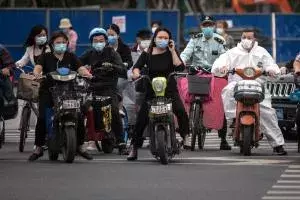Error message

By Christopher A. McNally
HONOLULU (1 June 2020)—The impact of the COVID-19 global pandemic makes forecasting our economic future even more difficult than under normal circumstances. It is clear, however, that the pandemic will wreak unprecedented damage to the global economy, with profound implications for economic relations between the US and China.
Perhaps the closest parallel is the 1918 flu pandemic, but that occurred in a different era. The global economy was just emerging from the shock of World War I, and world economic integration was far lower than it is today. The SARS crisis in 2003 and other recent epidemics, such as Ebola and MERS, pale in comparison to the global scale, rapid spread, and deep economic impact of COVID-19.
Prolonged economic slowdown likely in both countries
What does the pandemic mean for the future of US-China economic relations? To address this question, it is pertinent to understand the economic backdrop on both sides of the Pacific. The impact of the virus on the global economy will be more severe than that of other recent, more localized epidemics, and both the US and China will be grappling with substantial domestic economic slowdowns.
These slowdowns may last far longer than most expect. The experience of China, the first country to suppress the virus in its initial wave, illustrates the difficulty of engineering a rapid economic recovery. While most indicators point to an upswing in Chinese manufacturing, exports are expected to remain soft due to a decline in demand from the US and the European Union.
The Chinese services sector, now the largest part of the economy, will face intractable problems as well. Restaurants and small shops are just starting to reopen amid continued consumer wariness about a possible second wave of the virus. Sectors such as travel and entertainment are still nowhere close to normal levels.
All of this indicates that the duration of the global pandemic and its negative economic influence could endure. As one historical study covering centuries of data indicates, the economic damage from pandemics can persist for 40 years. By contrast, wars and natural catastrophes, such as earthquakes and hurricanes, tend to destroy capital that must then be rebuilt. As a result, such disasters often trigger construction booms that lead to rapid economic recoveries, such as seen after World War II.
Pandemics do not destroy capital stock but rather suppress consumption for a long time. Many consumers will engage in precautionary saving due to increased economic uncertainty. Moreover, consumption patterns are likely to shift in the long term—more people will dine at home rather than in restaurants, and more companies will employ video-conferencing to avoid business travel.
The speed and strength of the recovery also depend on how the pandemic plays out in each locality, especially the effectiveness of containment. Contrary to what some are advocating in the US, the more effectively social distancing and testing regimes are implemented, the more successfully the pandemic can be managed, and the more rapidly the economy will recover.
Economic relations more important than ever
With both the US and China facing prolonged economic sluggishness, if not outright depressions, the bilateral relationship between the globe’s two largest economies faces massive challenges. Making matters worse, Washington and Beijing have attempted to divert domestic attention away from their own substantial shortcomings in how the pandemic was handled by blaming each other.
These blame games have damaged the already shaky bilateral relationship. President Trump has alluded to his desire to punish China for the spread of the coronavirus, including by imposing more tariffs on Chinese imports. In Beijing, hawkish voices have emerged seeking a reevaluation of the phase-one trade deal China signed with the US back in mid-January.
One major bone of contention is China’s commitment to purchase an additional $200 billion in US exports by the end of 2021, an aspect of the trade deal that President Trump has touted. According to a recent report by the Center for Strategic and International Studies, American exports to China of manufactured goods, agricultural products, energy, and services are likely to total only $57 billion this year.
Given this massive gap between China’s commitments and what is likely to occur, President Trump nonetheless remains unwilling to renegotiate the deal, setting both sides up for a difficult stalemate with no clear road forward. The reality, however, is that both sides need each other more than ever.
China’s manufacturing sector possesses competitive advantages that cannot easily be replicated elsewhere. There is no other economy on earth that can ramp up manufacturing as rapidly and massively as China can. In the short space of the month of February, for example, Chinese production capacity for face masks increased more than five-fold, surging from 20 million to 110 million per day, with 3,000 new firms entering the market—although that surge came with an inevitably high percentage of shoddy products.
What goes for face masks applies to many other industrial sectors. While calls for
economic decoupling from China and moving supply chains back to the US have grown louder with the onset of the pandemic, China’s global economic functions cannot easily be replaced.
The dual supply and demand shocks created by the pandemic are now causing chaos in trading relations. New Chinese restrictions to assure better quality for exports of face masks and other medical goods have disrupted supply chains in the US. And American businesses might not even be able to fulfill the Chinese purchase commitments under the phase-one trade deal as rolling shutdowns affect important sectors, such as meat processing. Against this environment, US-China economic relations are in urgent need of some certainty and synchronization.
Given the economic uncertainty, each side has limited leverage to force the other into making concessions. Harsh rhetoric only serves to inflame tensions at the worst possible time. Taking on China in a US presidential election year might seem like a good strategy, but it could easily backfire if the trade war of the past two years is reignited. For better or worse, the US and China are locked in a messy economic marriage. A divorce at this time would exact an enormous cost in an already weakened economy.
###
Download a PDF version of this Wire article.
Christopher A. McNally is an Adjunct Senior Fellow at the East-West Center and a Professor of Political Economy at Chaminade University. He can be reached at [email protected].
The views expressed do not necessarily reflect the policy or position of the East-West Center or of any other organization.
The East-West Wire is a news, commentary, and analysis service provided by the East-West Center in Honolulu. All or any part of the Wire content may be used by media with attribution to the East-West Center or the person quoted. To receive Wire articles via email, subscribe here. For links to all East-West Center media programs, fellowships and services, see EastWestCenter.org/Journalists.
The full list of East-West Wires produced by the Research Program is available on the East-West Center website at EastWestCenter.org/Research-Wire. For more on the East-West Center Research Program, see EastWestCenter.org/Research.
The East-West Center promotes better relations and understanding among the people and nations of the United States, Asia, and the Pacific through cooperative study, research, and dialogue.
Series editors:
Derek Ferrar
[email protected]
Sidney B. Westley
[email protected]
Photo: Effective social distancing and testing can speed up economic recovery: Residents of Wuhan, China, back on the street after the government began lifting some of the world’s tightest restrictions. Credit: Getty Images AsiaPac.
By Christopher A. McNally
HONOLULU (1 June 2020)—The impact of the COVID-19 global pandemic makes forecasting our economic future even more difficult than under normal circumstances. It is clear, however, that the pandemic will wreak unprecedented damage to the global economy, with profound implications for economic relations between the US and China.
Perhaps the closest parallel is the 1918 flu pandemic, but that occurred in a different era. The global economy was just emerging from the shock of World War I, and world economic integration was far lower than it is today. The SARS crisis in 2003 and other recent epidemics, such as Ebola and MERS, pale in comparison to the global scale, rapid spread, and deep economic impact of COVID-19.
Prolonged economic slowdown likely in both countries
What does the pandemic mean for the future of US-China economic relations? To address this question, it is pertinent to understand the economic backdrop on both sides of the Pacific. The impact of the virus on the global economy will be more severe than that of other recent, more localized epidemics, and both the US and China will be grappling with substantial domestic economic slowdowns.
These slowdowns may last far longer than most expect. The experience of China, the first country to suppress the virus in its initial wave, illustrates the difficulty of engineering a rapid economic recovery. While most indicators point to an upswing in Chinese manufacturing, exports are expected to remain soft due to a decline in demand from the US and the European Union.
The Chinese services sector, now the largest part of the economy, will face intractable problems as well. Restaurants and small shops are just starting to reopen amid continued consumer wariness about a possible second wave of the virus. Sectors such as travel and entertainment are still nowhere close to normal levels.
All of this indicates that the duration of the global pandemic and its negative economic influence could endure. As one historical study covering centuries of data indicates, the economic damage from pandemics can persist for 40 years. By contrast, wars and natural catastrophes, such as earthquakes and hurricanes, tend to destroy capital that must then be rebuilt. As a result, such disasters often trigger construction booms that lead to rapid economic recoveries, such as seen after World War II.
Pandemics do not destroy capital stock but rather suppress consumption for a long time. Many consumers will engage in precautionary saving due to increased economic uncertainty. Moreover, consumption patterns are likely to shift in the long term—more people will dine at home rather than in restaurants, and more companies will employ video-conferencing to avoid business travel.
The speed and strength of the recovery also depend on how the pandemic plays out in each locality, especially the effectiveness of containment. Contrary to what some are advocating in the US, the more effectively social distancing and testing regimes are implemented, the more successfully the pandemic can be managed, and the more rapidly the economy will recover.
Economic relations more important than ever
With both the US and China facing prolonged economic sluggishness, if not outright depressions, the bilateral relationship between the globe’s two largest economies faces massive challenges. Making matters worse, Washington and Beijing have attempted to divert domestic attention away from their own substantial shortcomings in how the pandemic was handled by blaming each other.
These blame games have damaged the already shaky bilateral relationship. President Trump has alluded to his desire to punish China for the spread of the coronavirus, including by imposing more tariffs on Chinese imports. In Beijing, hawkish voices have emerged seeking a reevaluation of the phase-one trade deal China signed with the US back in mid-January.
One major bone of contention is China’s commitment to purchase an additional $200 billion in US exports by the end of 2021, an aspect of the trade deal that President Trump has touted. According to a recent report by the Center for Strategic and International Studies, American exports to China of manufactured goods, agricultural products, energy, and services are likely to total only $57 billion this year.
Given this massive gap between China’s commitments and what is likely to occur, President Trump nonetheless remains unwilling to renegotiate the deal, setting both sides up for a difficult stalemate with no clear road forward. The reality, however, is that both sides need each other more than ever.
China’s manufacturing sector possesses competitive advantages that cannot easily be replicated elsewhere. There is no other economy on earth that can ramp up manufacturing as rapidly and massively as China can. In the short space of the month of February, for example, Chinese production capacity for face masks increased more than five-fold, surging from 20 million to 110 million per day, with 3,000 new firms entering the market—although that surge came with an inevitably high percentage of shoddy products.
What goes for face masks applies to many other industrial sectors. While calls for
economic decoupling from China and moving supply chains back to the US have grown louder with the onset of the pandemic, China’s global economic functions cannot easily be replaced.
The dual supply and demand shocks created by the pandemic are now causing chaos in trading relations. New Chinese restrictions to assure better quality for exports of face masks and other medical goods have disrupted supply chains in the US. And American businesses might not even be able to fulfill the Chinese purchase commitments under the phase-one trade deal as rolling shutdowns affect important sectors, such as meat processing. Against this environment, US-China economic relations are in urgent need of some certainty and synchronization.
Given the economic uncertainty, each side has limited leverage to force the other into making concessions. Harsh rhetoric only serves to inflame tensions at the worst possible time. Taking on China in a US presidential election year might seem like a good strategy, but it could easily backfire if the trade war of the past two years is reignited. For better or worse, the US and China are locked in a messy economic marriage. A divorce at this time would exact an enormous cost in an already weakened economy.
###
Download a PDF version of this Wire article.
Christopher A. McNally is an Adjunct Senior Fellow at the East-West Center and a Professor of Political Economy at Chaminade University. He can be reached at [email protected].
The views expressed do not necessarily reflect the policy or position of the East-West Center or of any other organization.
The East-West Wire is a news, commentary, and analysis service provided by the East-West Center in Honolulu. All or any part of the Wire content may be used by media with attribution to the East-West Center or the person quoted. To receive Wire articles via email, subscribe here. For links to all East-West Center media programs, fellowships and services, see EastWestCenter.org/Journalists.
The full list of East-West Wires produced by the Research Program is available on the East-West Center website at EastWestCenter.org/Research-Wire. For more on the East-West Center Research Program, see EastWestCenter.org/Research.
The East-West Center promotes better relations and understanding among the people and nations of the United States, Asia, and the Pacific through cooperative study, research, and dialogue.
Series editors:
Derek Ferrar
[email protected]
Sidney B. Westley
[email protected]
Photo: Effective social distancing and testing can speed up economic recovery: Residents of Wuhan, China, back on the street after the government began lifting some of the world’s tightest restrictions. Credit: Getty Images AsiaPac.
East-West Wire
News, Commentary, and Analysis
The East-West Wire is a news, commentary, and analysis service provided by the East-West Center in Honolulu. Any part or all of the Wire content may be used by media with attribution to the East-West Center or the person quoted. To receive East-West Center Wire media releases via email, subscribe here.
For links to all East-West Center media programs, fellowships and services, see www.eastwestcenter.org/journalists.







